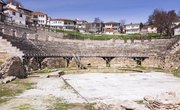Greek architecture has been credited as the basis of modern architecture. The reach of its influence has crossed centuries, from the Romans to the Renaissance and into present day design, as can be seen in capital buildings and courthouses across the United States, for example. The Greeks adopted the columns from the Egyptians, Minoans and Mycenaeans. The Greeks used columns to create large open-air temples that housed great works of sculpture in homage to their gods. Greek columns can be divided into three categories: Doric, Ionic and Corinthian.
Doric Columns
The Parthenon in Athens, built in the mid fifth century B.C., is the iconic example of the Greek Doric column. The Doric column is characterized by both its simplicity and its imposing appearance. It has a thick, baseless trunk that grows narrower as it climbs towards a simple, unadorned capital, topped by a square abacus. Very early Doric columns were made of wood, and later of stone, specifically marble. The Doric columns were used mainly during the Archaic Period of Ancient Greece (750 to 480 B.C.) and were used principally on mainland structures.
Ionic Columns
The Ionic column is identified by the scroll at the top as seen on the columns of the The Temple of Athena Nike in Athens and other temples of the Acropolis. It was also used during the Archaic Period, but was more popular on the Aegean Islands than on the mainland. Unlike the Doric column, the Ionic column had a large base of stacked rings and was taller and more slender.
Corinthian Columns
The Corinthian column was developed in Athens in the fifth century B.C., during the Late Classical Period. Like the Ionic column, it also employed a base, but was even more slender and was characterized by its capital, which was adorned with acanthus and fern leaves and small scrolls. The Temple of Zeus at Athens, built in the second century B.C. is one of the structures best known for its Corinthian columns. Though developed by the Greeks, the Corinthian style is actually more associated with Roman architecture.
Optical Illusion Effects Created by the Columns
Many Greek structures were engineered to be seen from the outside, and architects carefully orchestrated specific angles and calculations to create various optical illusions. The structure of the columns was an important part of this feature. All three styles of columns employed the use of entasis -- the widening of the center and the top of the column to create the optical illusion that the columns were perfectly straight. The columns also sat at slight angles to each other in order to create this same illusion.
Related Articles
Writer Bio
Lynn Blanch is a writer, translator and educator. She is the co-founder of an educational/cultural nonprofit in Brazil, speaks fluent Portuguese and has published a travel blog. She holds a bachelor's degree in liberal arts from Sarah Lawrence College.











